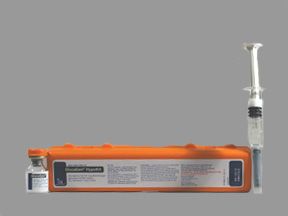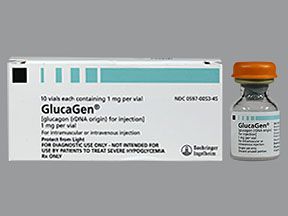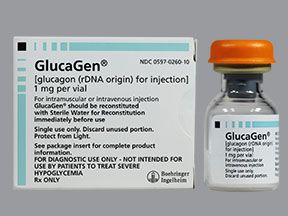If you have diabetes, your doctor might suggest GlucaGen as a treatment option. It’s a prescription drug used for the following:
- to treat severe hypoglycemia (low blood sugar) in adults and children with diabetes
- to pause movement of the digestive tract in adults undergoing certain diagnostic tests
The active ingredient in GlucaGen is glucagon. (An active ingredient is what makes a drug work.) Glucagon belongs to a class of medications called glucose elevating drugs.
GlucaGen comes as a powder that you, a caregiver, or a healthcare professional will mix with sterile water to make a liquid solution. This solution is then given as one of the following:
While you may give yourself injections under your skin and into your muscle, only a healthcare professional may inject GlucaGen into your vein.
This article describes the dosages of GlucaGen, as well as its strength and how to take it. To learn more about GlucaGen, see this in-depth article.
Note: This article covers GlucaGen’s usual dosages provided by the drug’s manufacturer. But when using GlucaGen, always take the dosage your doctor prescribes.
This section covers standard GlucaGen, GlucaGen Diagnostic Kit, and GlucaGen HypoKit dosages and administration information. Before prescribing this medication, your doctor will go over dosage instructions specific to your needs.
What are the forms of GlucaGen?
GlucaGen comes in the following forms:
- GlucaGen HypoKit: This kit contains 1 milliliter (mL) of sterile water in a syringe and 1 milligram (mg) of GlucaGen in a single-dose vial.
- GlucaGen Diagnostic Kit: This kit comes with 1 mL of sterile water in a syringe and 1 mg of GlucaGen in a single-dose vial.
- GlucaGen 1-mg single-dose vial
What strength does GlucaGen come in?
GlucaGen comes in one strength: 1 mg of the drug per 1 mL (1 mg/1 mL) of sterile water.
What are the usual dosages of GlucaGen?
Your doctor will usually start you on a low dosage of GlucaGen. But they may have you use more if your symptoms don’t improve after your first dose.
The information below describes dosages that are commonly used or recommended. But be sure to take the dosage your doctor prescribes for you. They’ll determine the best dosage to fit your needs.
Dosage for severe low blood sugar
The recommended GlucaGen HypoKit dosage for severe hypoglycemia (low blood sugar) is 1 mg/1 mL of sterile water. It’s injected as a single dose in one of the following ways:
- under the skin
- into a muscle
- into a vein (only a healthcare professional may inject the drug into your vein)
If symptoms are not relieved after 15 minutes, a second 1-mg dose may be injected using a new kit.
Dosage for use with certain radiology exams
The recommended dosage for use with diagnostic tests varies depending on which part of the digestive tract your doctor needs to treat. After your doctor decides the correct dosage for your condition, they’ll inject it as a single dose.
The following chart shows recommended GlucaGen dosages for use with diagnostic tests. (Note that each mg of the drug comes in 1 mL of sterile water.)
| Injection type | Dosage to relax stomach or small intestine | Dosage to relax large intestine |
| Into a vein | 0.2 mg to 0.5 mg | 0.5 mg to 0.75 mg |
| Into a muscle | 1 mg | 1 mg to 2 mg |
What’s the dosage of GlucaGen for children?
The dosage of GlucaGen for children is based on their age and body weight in kilograms (kg)*. Each dose is injected as a single dose in one of the following ways:
- under the skin
- into a muscle
- into a vein (only a healthcare professional may inject the drug into a child’s vein)
A second dose may be given using a new kit if the child’s symptoms don’t improve after 15 minutes.
The following table shows GlucaGen HypoKit dosage for children with severe low blood sugar:
| Child’s weight | GlucaGen HypoKit dosage |
| 25 kg or more | 1 mg in 1 mL sterile water |
| Less than 25 kg | 0.5 mg in 0.5 mL sterile water |
| Unknown in children ages 6 years and older | 1 mg in 1 mL sterile water |
| Unknown in children ages 5 years and younger | 0.5 mg in 0.5 mL sterile water |
* One kg equals about 2.2 pounds (lb).
Is GlucaGen used long term?
Yes, GlucaGen is usually used as a long-term treatment when prescribed for episodes of low blood sugar. If you and your doctor determine it’s safe and effective for you, you’ll likely use it long term.
Dosage adjustments
GlucaGen is usually injected as a one-time dose when used for diagnostic testing.
When GlucaGen is used to treat severe low blood sugar, you can inject a second dose 15 minutes after the first if the first dose doesn’t work well enough.
The dosage of GlucaGen your doctor prescribes may depend on several factors. These include:
- the type and severity of the condition you’re using GlucaGen to treat
- your age
- your weight
- the form of GlucaGen you’re using
- how you’re injecting GlucaGen
- how well your body responds to GlucaGen (see “Dosage adjustments” under “What is GlucaGen’s dosage?”)
Your doctor will prepare and inject the GlucaGen Diagnostic Kit or single-use vial if you’re using the drug for certain diagnostic tests.
If you’re using GlucaGen HypoKit to treat severe hypoglycemia (low blood sugar), you can follow these step-by-step instructions on the drug manufacturer’s website.
Once you are fully awake and able to eat or drink after receiving a GlucaGen injection, you should consume 15 grams (g) of fast-acting carbohydrates.
Recovery from severe low blood sugar may require help from others. So be sure to let a caregiver or others around you know about your GlucaGen HypoKit and how to use it.
For information on GlucaGen expiration, storage, and disposal, see this article.
Accessible drug containers and labels
If you find it hard to read the prescription label on your medication, tell your doctor or pharmacist. Some pharmacies may provide medication labels that:
- have large print or use braille
- feature a code you can scan with a smartphone to change the text to audio
Your doctor or pharmacist may be able to recommend pharmacies that offer these accessibility features if your current pharmacy doesn’t.
Do not use more GlucaGen than your doctor prescribes, as this can lead to serious side effects.
Symptoms of overdose
Symptoms caused by a GlucaGen overdose can include:
- hypokalemia (decreased potassium levels)
- increased blood pressure
- increased heart rate
- nausea
- vomiting
- constipation
What to do in case you use too much GlucaGen
Call your doctor right away if you think you’ve injected too much GlucaGen. You can also call 800-222-1222 to reach the American Association of Poison Control Centers or use its online resource. But if you have severe symptoms, immediately call 911 (or your local emergency number) or go to the nearest emergency room.
The sections above describe the usual dosages provided by the drug’s manufacturer. If your doctor recommends GlucaGen for you, they’ll prescribe the dosage that’s right for you.
Remember, you should not change your dosage of GlucaGen without your doctor’s recommendation. Only take GlucaGen exactly as prescribed. Talk with your doctor if you have questions or concerns about your current dosage. Here are some examples of questions you may want to ask them:
- Will eating my regular foods affect my GlucaGen dosage for my diagnostic test?
- When will my child need to switch to an adult dosage of GlucaGen?
- Is it safe to use more than two doses of GlucaGen within 24 hours?
If you have type 2 diabetes, consider signing up for Healthline’s online newsletter. You can also connect with others who have type 2 diabetes by joining the Bezzy T2D community.
Q:
How will I know if my loved one needs a dose of GlucaGen?
AnonymousA:
GlucaGen should be given as soon as you recognize signs of severe hypoglycemia (low blood sugar). These can include:
- blurry vision
- difficulty concentrating
- dizziness
- fatigue (low energy)
- headache
- pale skin
- rapid heartbeat
- restlessness
- shakiness
- slurred speech
- sweating
Signs of dangerously low blood sugar include:
Severe low blood sugar can be life threatening. It’s important that you inject GlucaGen and seek emergency medical help as soon as you recognize these symptoms.
The Healthline Pharmacist TeamAnswers represent the opinions of our medical experts. All content is strictly informational and should not be considered medical advice.Disclaimer: Healthline has made every effort to make certain that all information is factually correct, comprehensive, and up to date. However, this article should not be used as a substitute for the knowledge and expertise of a licensed healthcare professional. You should always consult your doctor or another healthcare professional before taking any medication. The drug information contained herein is subject to change and is not intended to cover all possible uses, directions, precautions, warnings, drug interactions, allergic reactions, or adverse effects. The absence of warnings or other information for a given drug does not indicate that the drug or drug combination is safe, effective, or appropriate for all patients or all specific uses.



